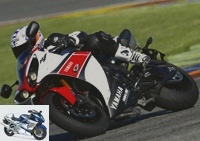2012 Yamaha YZF-R1 test: no revolution in the R

Despite its technological content and its fantastic Cross Plane engine, the R1 was beginning to suffer in the face of the most successful European hypersport motorcycles. To keep the vacuum in 2012, Yamaha offers traction control and reviews some details. Test !
It’s all under (traction) control !
Too interventionist on the sixth and last degree, the TCS shows its interest from the lower level and becomes downright "fun" from the fourth notch. The system then leaves much more freedom to the R1 – and especially to its pilot who can already copiously re-accelerate on the angle before seeing the TCS warning light signal the entry into action of the device. !
Soft and smooth, this intervention is hardly felt on the handlebars: ultra-fast, the central unit regulates the arrival of power via the electronic accelerator in complete transparency as soon as the rear seems to drift. At this moment, the pilot experiences the strange impression of being "pulled" backwards by a sort of giant hand, while the tachometer needle stagnates between two graduations. Respect !
Logically, the closer we get to the first level, the more the entry into action is delayed: by this mean that the Traction Control System now considers that you are sufficiently qualified to deal with marked losses of grip … Concretely, his intervention is then limited to "big" stalls.
Suffice to say that you probably missed a huge high side, or even a fall, when the TCS takes control of the first graduations and brings the rear wheel back to the axis of the motorcycle. !
This test, which we end with Michelin Power One and slightly hardened suspension settings in hydraulic (despite adjustments made to the rear spring, the shock absorber remains a bit flexible in track use), allows us to state without ambiguity that the ‘YZF-R1 is back in the race in 2012.
With tires with a sharper profile, the new Yamaha R1 is also significantly more agile and maneuverable. The extra grip offered by Clermont-Ferrand compounds even makes it possible to appreciate even more the benefits of traction control, because it is less stressed and becomes a kind of guardian angel who intervenes gently and effectively when the pilot is overly optimistic..
Certainly, some may regret that Yamaha did not take advantage of this development to review "the" lines and especially "the" line of its sporting flagship: with 206 kg all full, the R1 2012 shows a little overweight against lighter than its compatriots (198 and 199 kg without ABS for the ZX-10R and the CBR1000RR).
Likewise, the absence of an ABS or of a shifter (which makes it possible to shift gears without cutting the throttle) may disappoint some. But this relative technical "timidity" is not prohibitive: the R1 is one of the most sophisticated Japanese motorcycles and its traction control reinforces an already substantial technological content (electronic accelerator YCC-T, adjustable D-Mode injection, variable length intake air vents YCC-I, etc.).
In addition, Yamaha has already invested a lot and shown a lot of daring in 2009 by launching its Cross Plane engine directly derived from MotoGP. This block "M1 Replica" remains perfectly in the coup in 2012 and even stands out from the rest of the production by its solid character and its magical sound. !
Finally, last but not the least, Yamaha has managed to contain the price inflation on its R1 2012 which will be displayed at the same price as the current model: 15,999 euros. Available at the end of October in matt gray, white or blue, the new 2012 YZF-R1 will also be available in a "50th Anniversary" limited series at a price of 17,699 euros. In these conditions, how not to crack ?
Related articles
-
2012 Yamaha YZF-R1 test: no revolution in the R Despite its technological content and its fantastic Cross Plane engine, the R1 was beginning to suffer in…
-
All Tests – 2012 Yamaha YZF-R1 Test: no revolution in the R – Attraction for … traction!
2012 Yamaha YZF-R1 test: no revolution in the R Despite its technological content and its fantastic Cross Plane engine, the R1 was beginning to suffer in…
-
All Tests – 2012 Yamaha YZF-R1 Review: no revolution in the R – 2012 Yamaha YZF R1 Technical Sheet
2012 Yamaha YZF-R1 test: no revolution in the R Despite its technological content and its fantastic Cross Plane engine, the R1 was beginning to suffer in…
-
Yamaha YZF-R1 in the top test Don’t complain, work! After six years, Yamaha has completely redesigned the sporty top model, the YZF-R1. The result was a…
-
Yamaha R1 and R1M 2015 test: with or without M, we like ! Yamaha’s brand new sports bike is currently landing in French dealerships. But it was on the…
-
All Tests – 2012 BMW S1000RR Test: dreaded and formidable! – Bomb Track!
2012 BMW S1000RR test: dreaded and formidable ! Japanese manufacturers have long ruled the sportbike segment. But that was before BMW torpedoed the…
-
Tmax 2017 SX and DX test: Yamaha gives (sells) its maximum ! Yamaha is launching its new Tmax 530 2017, available in three models: the standard, the…
-
News – The new 2012 Yamaha YZF-R1 adopts traction control – Used YAMAHA
Youngtimer test Crazy They are definitely more exciting than modern dozen items. But how do the old stars BMW R 80/7, Kawasaki 900 Z1, Morini 31/2 and…
-
Honda CBR1000RR / SP 2017 test: neither gross nor submitted ! Forget the old CBR1000RR lacking in performance and technology: Honda celebrates 25 years…
-
All Tests – Yamaha SR400 test: the return of the granny – Do not push granny towards the exit
Yamaha SR400 test: the return of the granny Evicted from the French catalog in 1982, the SR400 reappeared in 2014! With its good old single-cylinder…